#newari artist
Explore tagged Tumblr posts
Text
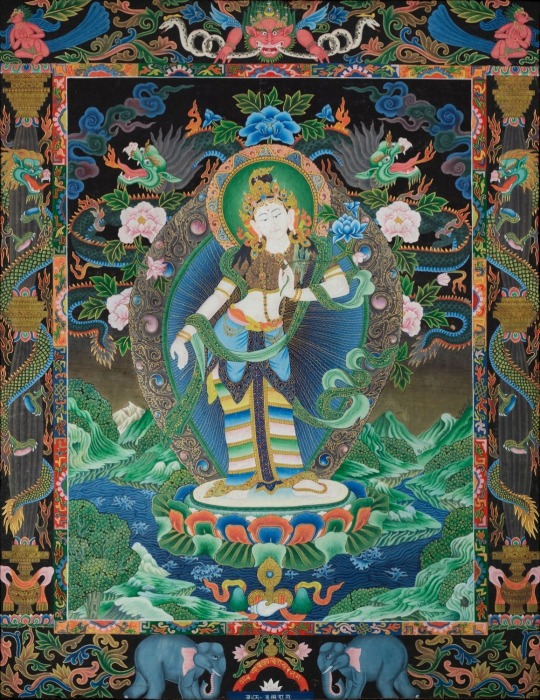
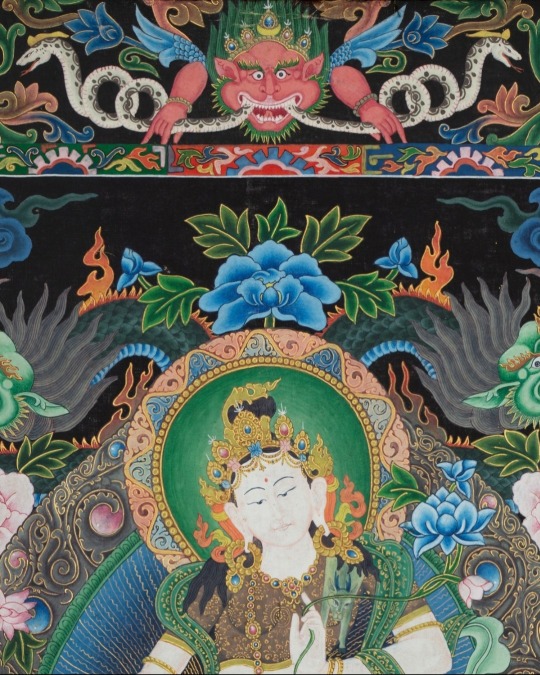
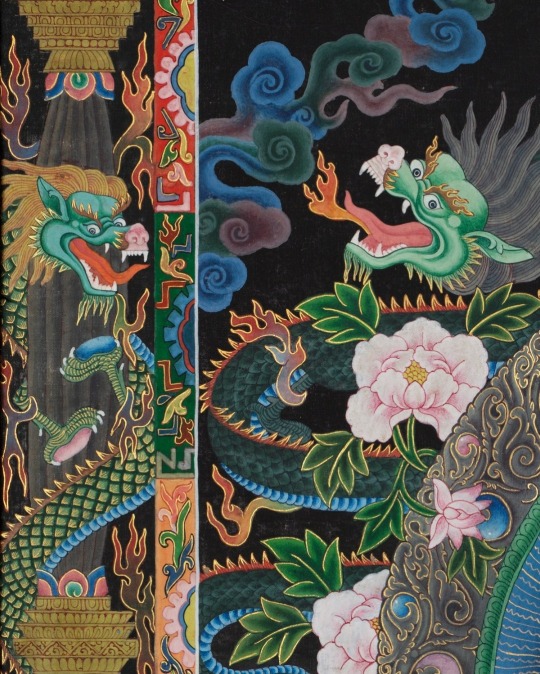

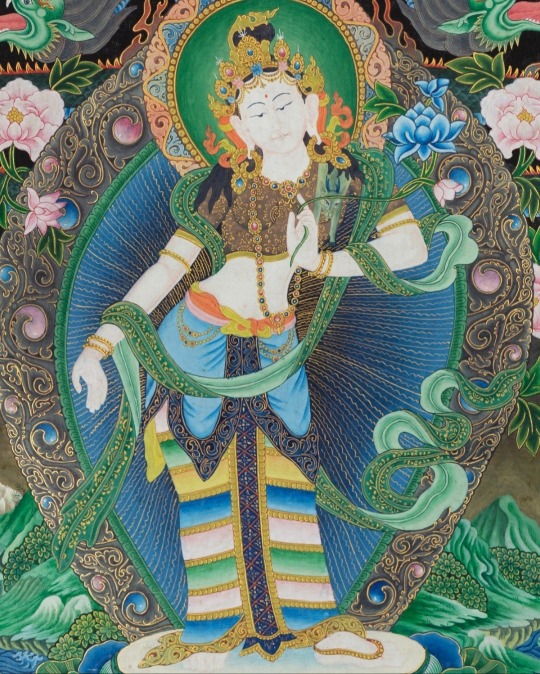
Newari Style Bodhisattva Padmapani Lokeshvara in 24 carat gold, gouache and acrylic colors on cotton canvas.
#no artist identification#buddhist art#newari#nepalese#thangka#buddhism#padmapani lokeshvara#bodhisattva
40 notes
·
View notes
Text
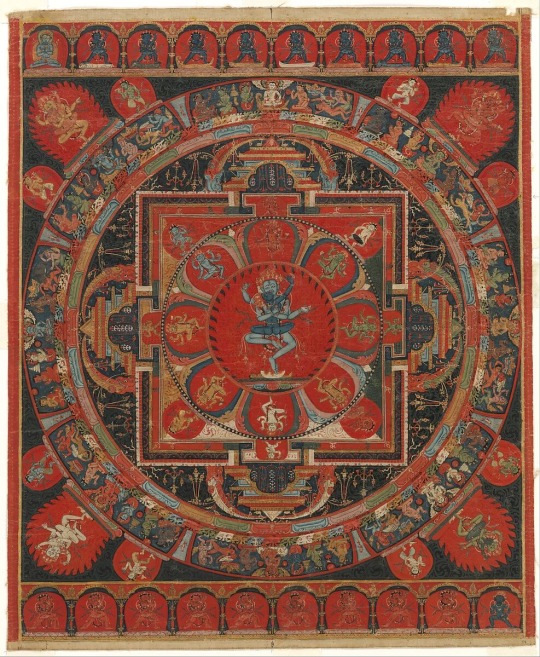
“Hevajra Mandala,” Tibet, 15th century
“Hevajra appears here in his three-headed and four-armed form. This manifestation is drawn from the Hevajra Tantra, a text revered by the Sakya order of Tibetan Buddhism, who likely commissioned this painting from a Newari artist from Nepal. Hevajra and his consort Nairatmya dance at the intersection of four vajra gateways, indicating their position at the center of the cosmos. His name is composed of two syllables: “he,” compassion, representing the male aspect, and “vajra,” wisdom, the female aspect, which together offer the path beyond this illusory world. The repeating skull symbolism references the impermanence of all phenomena. Beyond the celestial palace are the eight great charnel grounds, each presided over by a yogic master, or mahasiddha. On the reverse, in an ornate Tibetan lantsa script, are the Sanskrit mantra oh ah hum and mantra syllables configured in a stupa silhouette.”
-text via The Metropolitan Museum of Art
9 notes
·
View notes
Text
Kathmandu and Pokhara Day Tours: A Perfect Introduction to Nepal's Beauty
Nepal, a country renowned for its stunning landscapes and rich cultural heritage, offers travelers an array of exciting experiences. For those with limited time or those seeking a comprehensive overview of Nepal’s top destinations, day tours in Kathmandu and Pokhara provide an ideal solution. These tours offer a captivating glimpse into the essence of Nepal’s history, culture, and natural beauty.
Kathmandu Day Tours
Kathmandu, the bustling capital city, is a melting pot of tradition and modernity.Kathmandu Day Tours provides a fascinating journey through the city's historic and cultural landmarks. Key highlights include:
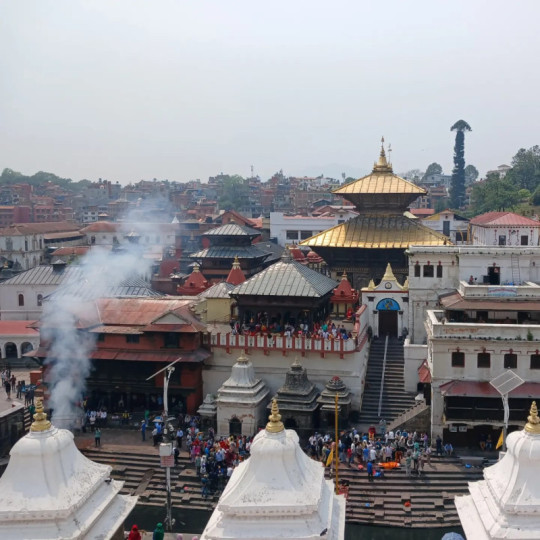
1. Swayambhunath Stupa (Monkey Temple): Perched atop a hill, this ancient stupa offers panoramic views of the Kathmandu Valley. Known as the Monkey Temple due to the large population of monkeys that inhabit the area, Swayambhunath is a revered Buddhist site featuring a prominent stupa and various shrines.
2. Durbar Square: Kathmandu’s Durbar Square, a UNESCO World Heritage Site, is home to an impressive array of temples, palaces, and courtyards. Highlights include the Hanuman Dhoka Palace, the Kumari Ghar (home of the living goddess), and the intricately carved Kasthamandap Temple.
3. Patan Durbar Square: Just a short drive from Kathmandu, Patan Durbar Square is known for its exquisite Newari architecture and artistic heritage. Visitors can explore the ancient Royal Palace, numerous temples, and the famed Patan Museum, which houses an extensive collection of art and artifacts.
4. Boudhanath Stupa: This colossal stupa is one of the largest in Nepal and a central hub for Tibetan Buddhism. The surrounding area is filled with monasteries, and the sight of the massive mandala-like stupa is both spiritually and visually stunning.
Pokhara Day Tours
Pokhara, known for its serene lakes and majestic mountain views, Pokhara Day Tours offers a range of picturesque day tours that highlight its natural beauty. Key experiences include:
1. Phewa Lake: A boat ride on Phewa Lake is a tranquil experience. Visitors can enjoy the stunning reflections of the surrounding mountains on the lake’s surface and visit the Tal Barahi Temple, located on an island in the middle of the lake.
2. Sarangkot: For panoramic views of the Himalayas, a sunrise trip to Sarangkot is a must. The viewpoint provides breathtaking vistas of the Annapurna and Dhaulagiri mountain ranges, especially at sunrise when the peaks are bathed in golden light.
3. World Peace Pagoda: This Buddhist stupa, located on a hill overlooking Pokhara, offers panoramic views of the surrounding landscape, including Phewa Lake and the distant mountains. The journey to the pagoda can be made by hiking or a short drive followed by a walk.
4. Devi’s Fall and Gupteshwor Cave: Devi’s Fall is a unique waterfall that plunges into a deep gorge. Nearby, Gupteshwor Cave features an impressive cave system with a sacred Shiva shrine.
Both Kathmandu and Pokhara offer enriching day tours that provide a deep dive into Nepal’s cultural heritage and natural splendor. Whether exploring the historic temples of Kathmandu or the tranquil beauty of Pokhara’s lakes and mountains, these day tours offer a memorable introduction to the diverse wonders of Nepal.
0 notes
Text
Ranjana Lipi: Efforts to revive the ancient script
What is Ranjana Lipi
The diverse culture of Nepal is home to many ethnic groups with over 100 various languages. In Nepal Mandal (the current Kathmandu Valley) from the 14th to 18th century, Nepal Bhasa was the official language but was replaced by Nepali after the Gorkha Kingdom was established. This Sino-Tibetan language is spoken by Newars, indigenous inhabitants of Kathmandu Valley, and has remained alongside Nepali as another prominent language of Nepal. Nepal Bhasa is written in Nepal Lipi, which has nine different variations. An artistic and distinctive script, Ranjana Lipi is one of those widely visible scripts among all the Nepal Lipi. It is commonly used to write the Buddhist Mantra “Om mane padme hum” in Buddhist Prayer Wheel.
Besides, it has been used on stone and copper plate inscriptions, coins, palm-leaf documents, and Hindu and Buddhist manuscripts. Ranjana script has not only been used in the Nepal but also in Tibet, where it is known as Lanydza. Tibetans typically decorate temple walls, prayer wheels, and Mandalas with this script and use it on the title pages of Tibetan texts.
Current situation
Throughout history, Nepal Bhasa and its script have faced many threats. Nepal Lipi has struggled a lot to maintain its existence in the history of Nepal. With the aim of preservation of Ranjana Lipi, Nepal Lipi Guthi came into existence. The institution, founded by Bikash Man Sheshya in 1980, has remarkably helped in spreading awareness about the importance of Nepal Bhasa.
Although organizations have successfully increased visibility among the people in recent decades, there is still much to do. Today, young adults are primarily aware, but few understand it or know how to write it.
However, the current situation among youngsters seems even more worrying, as many have not even heard of it. Younger generations need more opportunities and enticements to study the endangered Ranjana Lipi. Otherwise, it is in danger of vanishing.
Recently, Community Homestay Network have also acted and organized the event Ranjana Lipi & Aila in effort to support the endangered script. In addition to giving a wonderful cultural experience for the participants, this event has provided an opportunity for Kirtipur Community Homestay, as two of its representatives, Buddhilal Maharjan and Gyan Maharjan, facilitated as trainers to spread the script to reach more people.
We had an interview with the men, where important topics were discussed. In the conversation, Buddhilal and Gyan talk about their lives and challenges with the endangered Ranjana Lipi. They also discuss current and potential opportunities for its preservation.
Ranjana Lipi & Kirtipur Community Homestay
“It is not just a script, but the heritage and pride of all Nepali people,” Buddhilal Maharjan states. “Ranjana Lipi is the soul of the whole nation, and without the existence of it, the existence of the whole nation is questionable,” Gyan Maharjan continues. The men share an interest in the ancient Newari script and a passion for teaching it to others.
Buddhilal's Encounter: Nepal Lipi Guthi Connection
Retired jobholder, Buddhilal, and Gyan, who works in water supply, both have their roots in the ancient town of Kirtipur on the outskirts of Kathmandu. When discussing how they got involved with Ranjana Lipi, Buddhilal recalls: “I got to know about Ranjana Lipi through an organisation, Nepal Lipi Guthi, which was established for the script in 2036 B.S. (1979 AD).”
During Nepal Sambat (the New Year of the lunisolar calendar), he remembers how he helped the community by writing banners in Ranjana Lipi. Gyan, in turn, says that his first encounter with Ranjana Lipi happened during school days, around 2038 B.S. (1981 AD). “Seeing Ranjana Lipi on temples and banners got me very fascinated about the authenticity of it, and as a result, I used to make tattoos with a ballpoint to my hand when I was a kid,” he recalls with amusement.
After Gyan had learned more about Ranjana Lipi in 2052 B.S. (1995 AD), he started working in a small organisation established in Kirtipur, Nepal Lipi Parishad, through which they ran a month-long workshop to generate awareness. “However, the workshop ended up short when we were halted by Maoist (The Communist Party of Nepal),” Gyan closes the story.
In the interview, both Buddhilal and Gyan often mention the government of Nepal, which has not supported the spread of Ranjana Lipi much but once even limited it. This has served as motivation for them to teach it to others: “Just to go against the government, we started to teach in small communities,” Buddhilal reveals. Gyan mentions that his motivation, besides the government’s ignorance, came from believing the writing style was endangered. To preserve it, he wishes to teach it not just to the Newari community but to other communities and foreigners.
Challenges and preservation of the endangered script
Gyan and Buddhilal consider the biggest challenge in preserving Ranjana Lipi to be the government’s limited efforts. The government is responsible for attracting young people to learn Ranjana Lipi, but there has been no action: “People don’t see any advantage of learning Ranjana Lipi. Neither can they earn from learning the script, nor is there any job guarantee from the script.
That’s why people would rather learn Japanese or Korean because learning those languages can guarantee a job in a foreign country”, Gyan explains. They both believe that the government of Nepal could play a pivotal role in preserving the script.
Government's Role
According to them, to protect Ranjana Lipi, the government could organize workshops and arrange some opportunities to earn income through the script. “Today, people are also very busy and occupied with their own stuff and have limited time to learn new things. Even taking the time to learn Ranjana Lipi is a huge thing”, Gyan ponders other challenges.
Besides that, the men wish the government would take Ranjana Lipi into account in the school curriculum; they believe that it would be helpful if the script was still used in the writings in temples as well as in the products people use in modern days. “To keep it alive, Ranjana Lipi could be incorporated in poems, books, children’s cartoons, and songbooks, and even international short stories could be translated into Ranjana Lipi,” Buddhilal adds.
When asked about other methods for its preservation, the conversation turns to young people and how the nepalese calligraphy could be used in the products aimed at them: “Especially for younger generations, tattoos, posters, keyrings, lockets, and souvenirs would attract them,” Gyan considers.
Digital opportunities for Ranjana Lipi are also current, and the men see that there are many of them. Buddhilal digs out his cell phone from his pocket and introduces an application called Nepal Lipi – Ranjana Lipi. “People can use the app to convert Devanagari to Ranjana Lipi. I think it is the best platform to promote Ranjana Lipi,” he praises the app.
The Ranjana Lipi & Aila workshop
“We are thankful for the opportunity that Community Homestay Network offers people. Because of the event, we got the chance to reach more people,” Gyan expresses his gratitude. The event Ranjana Lipi & Aila has been held twice now, and there is more to come. It is inspired by the “Paint and sip” type of events, but instead of contemporary paintings, papers are decorated with Ranjana Lipi, while traditional Aila is served as a drink. At the event, the trainers teach participants the basics of the script while offering an opportunity to immerse themselves in Newari culture.
Community-Led Preservation Efforts
Community Homestay Network is not the only organization that have organized such events regarding Ranjana Lipi. As Buddhilal mentioned, there have also been efforts made by Nepal Lipi Guthi; an institution focused on the Newar language and script: “Along with this event, there was this event called Calijatra. It is an open participation event, and people would come and write down their names in Ranjana Lipi and learn the basics of it.” Established in 2015, Calijatra has, until now, organized over 40 workshops all over Nepal (Khadgi, 2020)
“The Newari community appreciates the efforts to teach Ranjana Lipi from different organisations. As there are not any efforts from the government to teach it, people have taken it upon themselves to preserve the endangered script”, Buddhilal explains.
People’s efforts have borne fruit because these days Ranjana Lipi can be seen more in different places, for example “in letter pads, headings of newspapers and on boards of government offices,” he lists. Gyan thinks that these kinds of events are essential for people interested in cultures and also help young people who nowadays don’t know much about the script get to know it. He notes that Advertising through social media such as Facebook and Instagram could attract youth to learn it.
Community Impact
The men discuss that the event’s impact on their community would be even more significant if CHN expanded it to different neighbourhoods. This way, more people of different ages and backgrounds would be reached. “If we keep on organising this kind of event, it might inspire other organisations to organise the same kind of events, too,” Buddhilal mentions. Gyan, in turn, brings up the possibility that a package with more time rather than just an event could attract more participants and be more effective.
When asked about their experience as trainers in the two past events, both say they were happy to see the participants enjoying the event. “The enjoyment from participants’ was fuel for us, and we are looking forward to future events with great enthusiasm,” Buddhilal adds in the conversation.
Gyan mentions he found the event very interesting, not only because of teaching but also interesting because of many other Newari cultural components. “I want to highlight the almost endangered culture of the Newari community, like serving Saakha: ti (traditional Newari beverage) while welcoming guests,“ he says. “Not just the script, but I want the culture of the Newari people to be promoted at this event,” Buddhilal agrees.
Conclusion
The historical significance of Ranjana Lipi is not limited regionally only to Nepal. “Talking about the historical importance of Ranjana Lipi, it can be stressed back to many Asian countries, such as Tibet, China, and Japan. It has travelled the world with prayer wheels.” Buddhilal explains.
The men emphasize the importance of Ranjana Lipi as a valuable cultural heritage: “Most of our historical and religious books are written in Ranjana Lipi. They are not just books but heritages, so to preserve this kind of heritage and obtain knowledge from the books, its preservation is required”, Buddhilal states.
As a valuable part of Nepal’s rich cultural heritage, Ranjana Lipi has united the nation’s identity, tying together different generations and groups of people. Like many other ancient scripts, Ranjana Lipi has also faced difficulties and was in danger of disappearing.
Nevertheless, it continues to flourish today, for which we can thank the efforts of the organizations and the strong unified identity of the Newari community, with the power of which they have kept it alive, passing the heritage from generation to generation. An excellent example of how even one event can arouse others and create something bigger is Ranjana Lipi & Aila.
The event has inspired members of the Kirtipur Community Homestay to take the reins of preservation by spreading the script among their community and teaching it to those interested in it, including tourists. We must protect cultural heritage as it is part of the past, part of ourselves, and a source of identity.
Reference: Khadgi, A. 2020. A man with many hats. The Kathmandu
1 note
·
View note
Text
Exploring Kathmandu on Two Wheels: A Motorbike Tour Adventure
Nestled in the heart of the Himalayas, Kathmandu, the vibrant capital of Nepal, pulsates with a unique blend of ancient traditions and modern energy. For adventure enthusiasts, a Motorbike Tour in Kathmandu offers an exhilarating and immersive way to uncover the city's hidden gems, from historic temples and bustling markets to the charming backstreets. In this blog, we embark on a virtual ride through the cultural kaleidoscope of Kathmandu, exploring the city's iconic landmarks and the thrill of navigating its bustling streets on two wheels.

1. The Roar of Engines: Starting Your Kathmandu Motorbike Adventure
The journey begins with the roar of engines as riders kickstart their motorbikes in the heart of Kathmandu. Whether you're a seasoned rider or a novice adventurer, navigating the city's bustling streets on a motorbike adds an extra layer of excitement to the exploration.
2. Swayambhunath Stupa: The Majestic Monkey Temple
The first stop on the Motorbike Tour is the iconic Swayambhunath Stupa, also known as the Monkey Temple. Perched atop a hill, this UNESCO World Heritage Site offers panoramic views of Kathmandu Valley. Riders can ascend the spiraling staircase and soak in the spiritual ambiance while mingling with the resident monkeys.
3. Boudhanath Stupa: A Spiritual Oasis
Next on the itinerary is the colossal Boudhanath Stupa, a sacred pilgrimage site for Buddhists. The sight of the massive mandala and the gentle spin of prayer wheels create a serene atmosphere, providing riders with a tranquil pause in the heart of the city.
4. Thamel: Riding Through the Heart of the City's Buzz
As riders navigate through Kathmandu's vibrant streets, the next destination is Thamel, the city's bustling tourist hub. Known for its lively atmosphere, eclectic shops, and diverse eateries, Thamel invites riders to explore its narrow alleys and discover the vibrant energy of Kathmandu.
5. Durbar Square: A Historical Ride Through Time
A Motorbike Tour in Kathmandu would be incomplete without a visit to Durbar Square. This historical complex, surrounded by ancient palaces and intricately carved temples, provides riders with a glimpse into Nepal's royal past. The blend of architecture and the lively atmosphere of the square make it a must-see destination.
6. Pashupatinath Temple: Spiritual Resonance
Heading towards the eastern part of the city, riders reach Pashupatinath Temple, one of the holiest Hindu shrines globally. The sacred Bagmati River, ancient temples, and the spiritual resonance of the area offer a unique cultural experience amid the bustling cityscape.
7. Patan Durbar Square: A Ride to Artistic Heritage
The final leg of the Motorbike Tour takes riders to Patan Durbar Square, located in the neighboring city of Lalitpur. This artistic haven is adorned with intricately designed temples, courtyards, and historic monuments, showcasing the rich cultural heritage of the Kathmandu Valley.
8. The Joys of Street Food: Culinary Pitstops
No Kathmandu adventure is complete without savoring the local cuisine. Riders can indulge in culinary delights at street-side stalls, trying local favorites like momo (dumplings), Newari delights, and a cup of traditional chiya (tea) to refuel for the journey ahead.
9. Best Time for a Motorbike Tour: Mild Seasons for Smooth Rides
The ideal time for a Motorbike Tour in Kathmandu is during the mild seasons of spring (March to May) and autumn (September to November). During these periods, the weather is pleasant, skies are clear, and riders can enjoy smooth rides through the city.
Conclusion: Unveiling Kathmandu's Charms on Two Wheels
A Motorbike Tour in Kathmandu offers riders not just a mode of transportation but a dynamic and immersive way to experience the city's rich tapestry. As engines hum through ancient streets, riders uncover the cultural, spiritual, and historical treasures that define Kathmandu. From the iconic stupas to the lively streets of Thamel, each twist and turn on two wheels is a journey through time and tradition.
So, rev up your engines, don your helmets, and let the Motorbike Tour in Kathmandu be your ticket to exploring the city's vibrant soul. This adventure promises not just the thrill of riding but a sensory voyage through the heart of the Himalayas, revealing the magic that lies within the streets of Kathmandu.
1 note
·
View note
Text
Nepal's Living History: A Walking Tour of Kathmandu's Durbar Squares

Kathmandu, the heart of Nepal, is a city steeped in history, culture, and tradition. One of the most captivating ways to immerse yourself in the rich heritage of this city is by embarking on a walking tour of its Durbar Squares and royal palaces. Each step you take unveils a chapter of Nepal's storied past.
Kathmandu's Durbar Squares: A Glimpse into the Past
Kathmandu boasts three Durbar Squares, each with its own unique character and historical significance. These squares are the former royal centers of the Kathmandu Valley, and they continue to be vibrant cultural hubs to this day. Here's what you can expect from a walking tour of these splendid heritage sites:
Kathmandu Durbar Square: The Heart of the City
Kathmandu Durbar Square, also known as Hanuman Dhoka Durbar Square, is a living testament to the city's royal history. As you explore the square, you'll encounter impressive palaces, courtyards, and temples, including the Hanuman Dhoka Durbar, the Kumari Ghar (home to the living goddess Kumari), and the stunning Taleju Temple. The intricately carved wooden structures, stone spouts, and artistic treasures are a feast for the eyes.
Bhaktapur Durbar Square: The Living Museum
A brief journey from the heart of Kathmandu takes you to the charming Bhaktapur, where you'll discover another gem known as Bhaktapur Durbar Square. This meticulously conserved square will whisk you away to a bygone era with its captivating architectural wonders and carefully preserved historic structures. As you explore, you'll come across enchanting attractions like the 55-Window Palace, the Nyatapola Temple, and the Golden Gate, each adding to the allure of your leisurely stroll.
Patan Durbar Square: A Hub of Art and Culture
Patan Durbar Square, located in the city of Lalitpur, is a melting pot of art and culture. The square is adorned with exquisite temples, museums, and courtyards, showcasing Newari architecture and craftsmanship at its finest. The Patan Museum, Hiranya Varna Mahavihar (Golden Temple), and Krishna Temple are highlights that provide a glimpse into the city's cultural heritage.
The Joy of Discovery
The essence of a walking tour through Kathmandu's Durbar Squares lies in the thrill of exploration. At every stride, you'll chance upon exquisitely carved doorways, concealed courtyards, and local artisans peddling age-old crafts. The ambiance buzzes with the vigor of daily life as locals conduct their routines, immersing you in a sensation of stepping back into a bygone era.
Discover Nepal's beauty with Welcome Nepal Treks, your trusted travel company in Kathmandu. We offer expertly guided treks, cultural tours, and adventures. Contact us today for an unforgettable journey.
Resource: https://nepaltourstravel69818096.wordpress.com/2023/11/04/nepals-living-history-a-walking-tour-of-kathmandus-durbar-squares/
#local travel agency in nepal#nepal tour company#local tour company in nepal#nepal tour agency#tour company in nepal#kathmandu tour agency#travel company in nepal#tour company in kathmandu#travel company in kathmandu#nepal travel agency
0 notes
Text
Elegance Redefined: Exquisite Blouse Designs for Saree in Nepal"
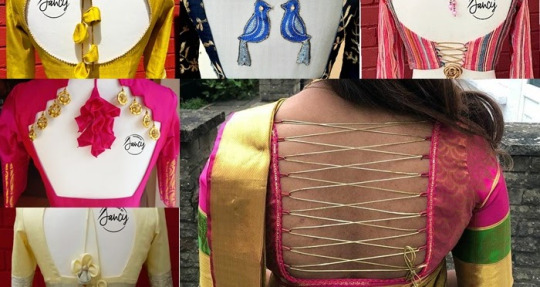
Introduction
In the land of majestic Himalayan peaks and rich cultural traditions, the saree has long been an emblem of grace and beauty. Nepal's diverse culture and heritage have given rise to a plethora of unique blouse designs for sarees in Nepal, where artistry meets fashion. Today, we embark on a journey through the intricate world of blouse designs, celebrating the timeless elegance of this traditional attire.
The Traditional Elegance of Pote Blouses
Nepal is renowned for its diverse communities, each contributing to the rich tapestry of Nepalese culture. One such tradition is the Newari community's exquisite pote blouses. These pote blouses are adorned with intricately crafted glass beads and shells, creating a stunning blend of tradition and modernity. Pote blouses are the perfect choice for those seeking to add a touch of heritage to their saree ensemble.
Timeless Brocade Magic
The timeless charm of brocade blouses is a favorite among Nepali women. These brocade saree blouses feature intricate patterns woven into the fabric, often embellished with metallic threads and sequins. The result is a shimmering masterpiece that perfectly complements any saree, be it for a wedding or a festive occasion. Brocade saree blouses add a touch of regal allure to your saree ensemble, making you feel like royalty.
Want to know more about How to Become a Fashion Designer?
Elegance in Simplicity: Plain Silk Blouses
Sometimes, less is more. Plain silk saree blouses, in their understated elegance, have a unique charm of their own. They allow the saree to take center stage while providing a classic and timeless look. The beauty of plain silk saree blouses lies in their versatility, making them suitable for both formal and casual events. In Nepal, the love for simplicity is celebrated, and these saree blouses capture that essence beautifully.
Contemporary Fusion: The Crop Top Blouse
As fashion evolves, so do the saree blouse designs in Nepal. The fusion of contemporary and traditional elements has given rise to the crop top saree blouse. These crop top saree blouses, with their shorter length and modern patterns, add a refreshing twist to the saree. They are perfect for the fashion-forward woman who wants to make a statement while embracing her cultural roots.
Embroidery Extravaganza
Nepal's diverse cultures and regions have brought forth an array of exquisite embroidery techniques. From the vibrant and intricate Tharu embroidery to the delicate and elegant Dhaka embroidery, these techniques add a touch of artistry to blouse designs. Embroidered saree blouses are a celebration of Nepal's rich craftsmanship and are a must-have for those who appreciate detailed craftsmanship.
The Magic of Traditional Dhaka Blouses
Dhaka fabric is a traditional Nepali textile known for its intricate patterns and vibrant colors. Dhaka saree blouses are a testament to the country's weaving heritage. These saree blouses feature stunning Dhaka fabric as their primary material, making them a statement piece for any saree ensemble. They beautifully showcase the fusion of tradition and fashion, making them a cherished addition to a Nepali woman's wardrobe.
Conclusion
In Nepal, the saree isn't just a piece of clothing; it's a canvas for artistic expression. The diversity of blouse designs for saree in Nepal reflects the nation's rich cultural heritage and its embrace of modernity. Whether you choose the traditional pote blouse, the timeless brocade, the simplicity of plain silk, the fusion of crop tops, the exquisite embroidery, or the magic of Dhaka saree blouses, your saree ensemble will be an ode to Nepal's elegance and beauty.
So, the next time you drape a saree in Nepal, remember that the blouse you choose is not just an accessory but a work of art that completes the masterpiece. Embrace the beauty of Nepali blouse designs for saree in Nepal, and let your saree ensemble tell a story of tradition, craftsmanship, and contemporary style. Each blouse design is a reflection of Nepal's cultural tapestry, a testament to its rich heritage, and a celebration of the timeless allure of the saree.
If you are interested also read: Kurtha Design For Men
#fashion designing#fashion school#interior design#diploma in fashion designing#diploma in interior designing#diploma in fashion#fashion design#fashion designing course#interior decor ideas#interior design course
1 note
·
View note
Text
Exploring the Enchanting World of Famous Art and Craft of Nepal
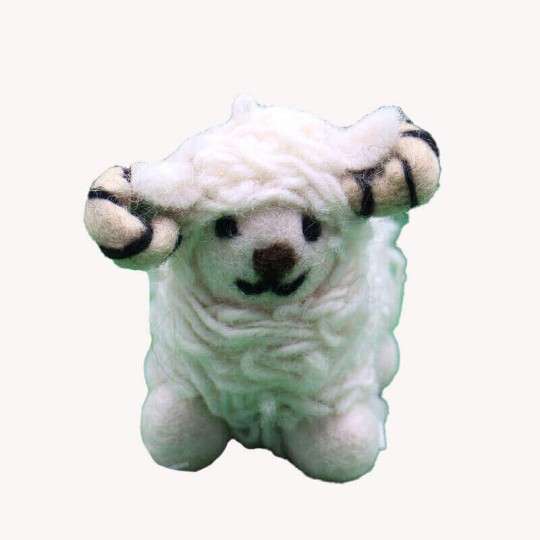
Nepal, nestled in the lap of the Himalayas, is a land of diverse cultures and artistic traditions that have flourished for centuries. Renowned for its breathtaking landscapes and rich cultural heritage, Nepal is equally celebrated for its famous art and craft, which reflect the country's deep-rooted spirituality and skilled craftsmanship. Let’s discuss about the enchanting art and craft of Nepal.
Thangka Paintings: Artistry in Divine Expression
Thangka paintings, intricate religious artworks, are a hallmark of Nepal's artistic legacy. These exquisite scroll paintings depict deities, mandalas, and cosmic symbols with meticulous attention to detail, often used for meditation and spiritual contemplation.
Wood Carvings: A Symphony of Art and Architecture
Nepali wood carvings adorn temples, palaces, and traditional buildings, showcasing the skillful craftsmanship and cultural symbolism. From intricately carved doors to ornate window frames, these wooden masterpieces are a testament to the fusion of art and architecture.
Metalwork: Glimpses of Elegance and Spirituality
Metalwork in Nepal encompasses an array of stunning creations, from graceful bronze statues of deities to finely crafted ritual objects like singing bowls and incense burners. Each piece carries a sense of spirituality and artistic finesse.
Pottery and Ceramics: Reviving Ancient Traditions
Nepali pottery and ceramics celebrate the country's ancient heritage. From utilitarian earthenware to exquisitely glazed ceramics, these creations reflect the harmonious relationship between art and daily life.
Handwoven Textiles: A Kaleidoscope of Colors and Patterns
Nepali handwoven textiles, such as Dhaka and Pashmina shawls, showcase the mastery of local weavers. The intricate patterns and vibrant colors narrate stories of cultural identity and craftsmanship.
Paper Crafts: Ancient Art in a Modern Context
Paper crafts like Lokta paper products and intricate paper masks connect Nepal's ancient traditions with contemporary creativity. These eco-friendly crafts blend heritage with innovation.
Thanka Artists: Guardians of Spiritual Heritage
Meet the skilled Thanka artists who dedicate their lives to preserving this ancient art form. Discover the meticulous process behind creating these sacred paintings and their significance in Nepali culture.
Newari Metal Crafts: A Glimpse into Kathmandu's Artistic Legacy
Explore the exquisite metal crafts produced by the Newar community in Kathmandu Valley. From brass statues to traditional utensils, Newari metalwork reflects the region's rich artistic heritage.
Handmade Jewelry: A Fusion of Elegance and Tradition
Discover the allure of Nepali handmade jewelry, featuring intricate designs inspired by Nepali culture and traditions.
Conclusion
The art and craft of Nepal provide a glimpse into the country's rich cultural fabric and artistic excellence. Spanning from ancient traditions to contemporary expressions, the masterpieces created by Nepali artisans are cherished not only within the Himalayan nation but also on a global scale. These artistic marvels embody timeless beauty & boundless creativity, captivating the hearts of art enthusiasts & cultural admirers worldwide.
#Nepal Handicraft Product#handicraft product in Nepal#Nepal Handicraft Wholesaler#Nepal Handicraft#Handicraft in Nepal#Nepal Handicrafts#Handicraft Shop in Nepal#Handicraft Export from Nepal#Handicraft Website#Nepal Handicrafts Wholesale#Online Nepal Craft#Art and Craft of Nepal#Nepali Handicrafts Online
1 note
·
View note
Text
Radio Nepal FM & AM + Radio Online + (Radio Android Application 🇳🇵📻)
Nepal is home to a rich and diverse array of radio stations, serving a population of over 28 million people across the country. From music and entertainment to news and current affairs, there are radio stations in Nepal to suit a wide variety of interests.
One of the most popular radio stations in Nepal is Radio Nepal, the national broadcaster. Radio Nepal operates several stations across the country, providing news, music, and cultural programming in a variety of languages, including Nepali, Maithili, and Newari. The station has a long history, having been founded in 1951, and is considered an important source of information and entertainment for many Nepalis.
Another popular national broadcaster is Kantipur FM, which is part of the Kantipur Media Group. Kantipur FM is known for its lively music programming, featuring both Nepali and international artists, as well as its popular talk shows and current affairs programs. The station is particularly popular among young people, and has a strong presence on social media platforms like Facebook and Twitter.
In addition to the national broadcasters, Nepal is also home to a number of regional and local stations. These stations cater to the unique needs and interests of specific communities, and often provide programming in local languages and dialects.
Some popular regional and local stations include Radio Sagarmatha in Kathmandu, which is known for its community-focused programming and support for local artists and musicians, and Radio Madanpokhara in Pokhara, which features a mix of news, music, and entertainment programming for the local population.
Nepal is also home to a thriving community radio sector, with over 300 community radio stations operating across the country. These stations are run by volunteers and often focus on issues and perspectives that are not well-represented in the mainstream media. They provide a valuable platform for local voices and perspectives, and often serve as important sources of information and education for rural and marginalized communities.
In conclusion, Nepal's radio landscape is rich and diverse, with a variety of broadcasters and programming to suit a wide range of interests and needs. From national and regional broadcasters to local and community-based stations, radio continues to play an important role in Nepali society, providing information, entertainment, and a platform for diverse voices and perspectives.
SO, DOWNLOAD NOW APP!! 🔽🔽
✔✔ GOOGLE PLAY STORE: ▶ https://play.google.com/store/apps/details?id=com.alexto.radio.nepal
✔✔ AMAZON APP STORE: ▶ http://www.amazon.com/gp/mas/dl/android?p=com.alexto.radio.nepal
✔✔ SAMSUNG GALAXY STORE: ▶ https://galaxystore.samsung.com/detail/com.alexto.radio.nepal
#radio#internet radio#radiostation#radio nepal#nepalese radio stations#radio nepal fm#radio nepal android#android#play store#amazon app store#samsung galaxy store
0 notes
Photo

Mandala of Kalachakra. Tibet. 1800s.
#mandala#kalachakra tantra#buddhist deity#sacred geometry#transcendental meditation#mysticism#19th century#newari artist#meditational art#buddhist monks#jonang#sakya#buddhist lineage#himalayan art dot org#magictransistor#alejandromerola#1800s
2K notes
·
View notes
Text
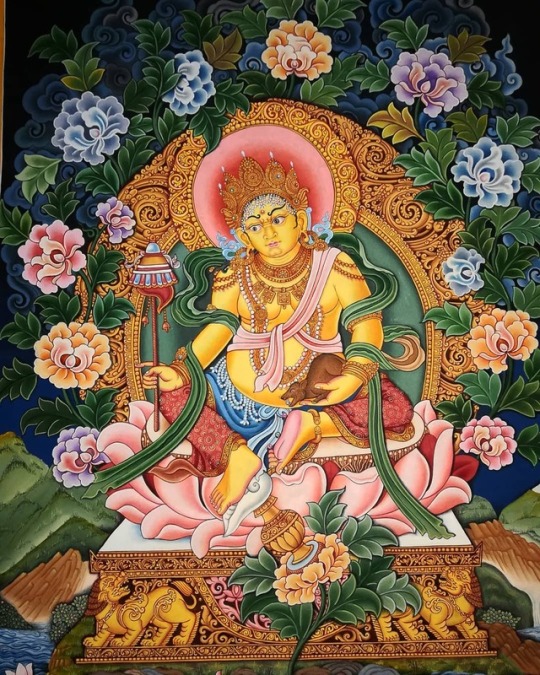
repost @mila0rispa3
Jambala, Unidentified Newari artist, 57 × 52 cm.
22 notes
·
View notes
Photo



'Hevajra Mandala, Tibet, 15th century © The Metropolitan Museum of Art'. Hevajra appears here in his three-headed and four-armed form. This manifestation is drawn from the Hevajra Tantra, a text revered by the Sakya School of Tibetan Buddhism, possibly the patrons of this painting. Hevajra and his consort Nairatmya dance at the intersection of four vajra gateways, indicating their position at the center of the cosmos. Hevajra’s name is composed of two syllables, “he,” compassion, representing the male aspect, and “Vajra,” wisdom, the female aspect, which together offer the path beyond the illusory world. The repeating skull symbolism references death and the impermanence of all phenomena. Beyond the celestial palace are the eight great charnel grounds, each presided over by a yogic master, or mahasiddha. On the reverse are inscriptions in an ornate Tibetan lantsa script of the Sanskrit mantra OH AH HUM and of mantra syllables configured in a stupa silhouette. This painting is likely the work of a Newari artist from Nepal working for a Tibetan patron.
6 notes
·
View notes
Text
Jason Todd, cryptid
- Sometimes, Jason will disappear for days, even weeks at a time. He never tells anyone where he went, and he doesn’t even acknowledge the fact that he was gone.
- He has weird hidden bits of knowledge that definitely weren’t part of his bat-training. Yes, he speaks Newari fluently, and yes, Tim, he’s aware that it’s an endangered language and you couldn’t find anyone outside of Nepal who speaks it. Where do you think he learned it?
- If Jason doesn’t want you to see or hear him, you won’t.
- They still don’t really know what happened in the time between Jason’s resurrection and his return to Gotham. If they’re bold enough to ask, he gives a vague answer and changes the topic.
- He has connections to people around the world that not even Bruce knows about. An eccentric Chinese tea artist with a knack for criminal gossip? A Russian former KGB agent? A retired Israel Defense Forces soldier who was trained by the guy who invented Krav Maga? Those are just the ones he’s mentioned in passing.
- Jason has been caught going to a church to pray multiple times. He doesn’t go to any services, and he says he isn’t religious.
- Before he died, Jason needed braces. He doesn’t anymore.
- He believes in ghosts. No, he won’t elaborate.
- Him and Cass have met before, although they didn’t recognize each other at first when Cass first showed up in Gotham. Neither of them will say when or how they met, but Jason can last the longest against her in a fight and he already knew Chinese Sign Language.
- He doesn’t scream. Ever. Even when he’s got the Scarecrows fear toxin running through his veins, he doesn’t make a sound.
- He’s capable of standing so still that you’d think he was still a corpse, but he usually comes out blurry in pictures. He likes to joke it’s because he makes sure the only pictures he’s clear in are ones that people ask for.
- His eyes have changed color. Most of the younger kids don’t know, but Tim does, and so does Bruce, and Dick, and Alfred. It makes his stare unnerving, more so than it already is.
- His eyes can also glow. In the dark shadows of the Batcave, or down a long, unlit hallway in the manor sometimes you’ll see his eyes emerge before the rest of him.
(pt. 2!)
3K notes
·
View notes
Photo
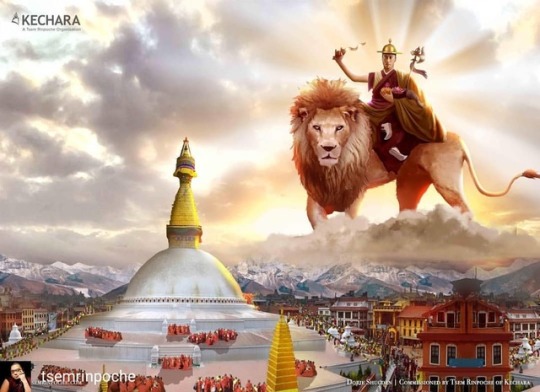
Reposted from @tsemrinpoche - An awe-striking depiction of Dorje Shugden appearing in the sky above the ancient Boudhanath stupa in Nepal. https://bit.ly/2Nt3FHz #tsemtulku #tsemrinpoche #kechara #buddha #buddhism #tibetanbuddhism #dorjeshugden #nepal #newari #boudha #boudhanath #stupa #protection #blessed #sacredart #arte #artistic #creativity #painting #drawing #holy #faith #tibet #kathmandu #meditation #peace #instagram #instamood #instagood #instacool www.tsemrinpoche.com www.dorjeshugden.org https://www.instagram.com/p/BzVwrG1BvLM/?igshid=1jqertcn0gv5o
#tsemtulku#tsemrinpoche#kechara#buddha#buddhism#tibetanbuddhism#dorjeshugden#nepal#newari#boudha#boudhanath#stupa#protection#blessed#sacredart#arte#artistic#creativity#painting#drawing#holy#faith#tibet#kathmandu#meditation#peace#instagram#instamood#instagood#instacool
0 notes
Photo

Necklace Inscribed with the Name of King Pratapamalladeva, 1645, Art Institute of Chicago: Asian Art
This ornament may have been given by King Pratapamalla (r. 1641–74), ruler of the Malla dynasty of Nepal, to Taleju Bhavani, the revered patron goddess of the old palace in Kathmandu and the chief protective deity of Nepal and its royal family. King Pratapamalla may also have worn this collar when he participated in rituals. This complex piece is composed of five principal strands and bears the inscription: “Victory to the Mother-Goddess [Bhagavati devi Janani]. Hail! [This] is the necklace of the king of kings, lord of kings, lord of the poets, the victorious Pratapamalladeva (may it be) auspicious!” The two innermost strands resemble rudraksha beads, made from the seeds of a large evergreen tree whose berries are commonly made into rosaries of 108 beads. Such prayer beads are most often worn by Shaivite ascetics, either around the neck or woven into their topknots. The third and fourth strands consist of tubular forms in a crescent shape known as hansuli. Each terminates in elaborate clasps, with the inner strand attached to a central amulet case. The outermost ring contains thirteen images of deities, including roundels of the eight mothers (ashtamatrikas), each depicted as the goddess Durga slaying the buffalo demon (Mahishasura). As this necklace was a royal commission, the finest Newari artists would have crafted it. Gift of the Alsdorf Foundation Size: 36.2 × 35.6 × 8.9 cm (14 1/4 × 14 × 3 1/2 in.) Medium: Gilt copper with semiprecious stones
https://www.artic.edu/artworks/130700/
7 notes
·
View notes
Text
4 Reasons Visiting Nepal Will Be A Lifetime Experience
This landlocked Himalayan nation boasts some of the best of everything for all kinds of travellers, including spectacular vistas of some of the highest mountains on the planet, fascinating culture, friendly locals, delectable cuisine, countless experiences, and incredible wildlife. The following 4 reasons will convince you to contact a local travel agency in Nepal and plan a trip to this country at least once in your lifetime.
You will encounter the varied culture:
More than 35 different ethnic groups call Nepal home, each with its own language, beliefs, festival, and artistic style. For instance, the Newar people, who were the first to settle in the Kathmandu Valley, still speak Newari, also known as Nepali Bhasa, and they still celebrate their own holidays, such as Swanti, a five-day festival that emphasises the importance of women in the home. You have a wonderful opportunity to step outside your comfort zone and become fully immersed in Nepal's unique cultures by travelling there.
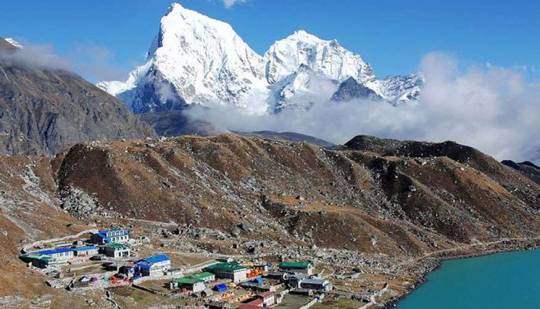
You will visit amazing historic locations:
Nepal can never let down lovers of history, art, and architecture because it is home to two magnificent UNESCO World Cultural Heritage Sites, Lumbini and Kathmandu Valley. While visiting Lumbini, the birthplace of Lord Buddha, can also be a joyful and illuminating experience, the Kathmandu valley, the spiritual centre of Nepal, is home to countless historic temples, lovely Buddhist monasteries, and stupas.
You'll come across the friendliest people on the earth:
The people of Nepal are incredibly friendly and inviting. They always work to make you feel at home because they think that visitors are God. They always offer you tea and aid when you ask for it. If you ask a friend who has been to Nepal before, they will tell you how hospitable the people there are.
You will enjoy Nepali cuisine:
Nepal's geographic and cultural variety contribute to its abundance of food. The cuisine of Nepal still has its own distinctiveness despite being heavily affected by its neighbours, China and India. You must consume some of Nepal's specialties before leaving the country. The national meal of Nepal, dal bhat (lentils with rice and curried vegetables), is available at practically every eatery and is eaten for breakfast, lunch, and dinner. The popular delicacy known as momo, or Nepalese dumplings, can be found on nearly every street corner and is well worth sampling several times. Chatamari, dheedo, aloo tama, and other well-known Nepali dishes that are worth trying.
0 notes